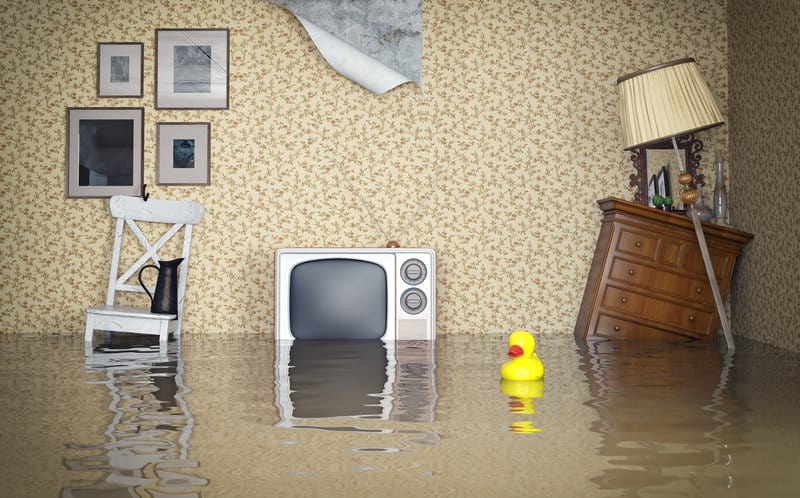
Purchasing the right homeowner’s insurance policy for your home is always a balance. The goal is to be adequately insured – saving money that would be wasted on over-insurance while keeping your home and assets safe if worst-case scenarios become a reality for your household. Flood insurance is one of those add-ons that can seem dubious – until your home is flooded and you find out you weren’t properly insured.
Some quick facts about flood insurance and flood insurance claims:
- Your lender may require you to have it
- The average flood insurance claim is $30,000
- Government aid for natural disaster comes largely in the form of loans, whereas insurance coverage is provided without repayment necessary on your end
Currently, the national average cost for flood insurance is $700 per year. However, that figure is notably less for those in low-risk zones and can be markedly higher for those in high-risk zones.
Guidelines For Adding Flood Insurance To Your Homeowner’s Policy
Here are some of the guidelines you should use to determine whether or not flood insurance makes sense for your home. Remember that these are only guidelines and we are not insurance professionals.
You should always discuss the details of your insurance policy with a trusted and experienced insurance agent to determine the best course of action in terms of risks and benefits for your street address. It’s best to speak with them before your move so you have less to deal with as you work through all of the transitions a move entails.
Your lender may require flood insurance
Depending on your street address, your lender may demand that flood insurance is added to your basic homeowner’s policy. In light of recent hurricane/storm-turned-flooding incidents – such as Hurricane Michael in March of 2019, generating 4,000+ flood insurance claims – lenders have become exacting in their demands that homeowners in high-risk flood zones – also called Special Flood Hazard Area – have a flood insurance policy.
You’re moving to an area that can flood anyway
So, if you don’t live in a Special Flood Hazard Area – that means you don’t need flood insurance, right? Not necessarily. According to houselogic.com, 20% of all flood insurance claims are filed by homeowners or renter who live in moderate- to low-risk flood zones.
Again, using Florida as an example, a FEMA Fact Sheet states, “…Florida, over the last five years, has exceeded that statistical probability, putting more homes and properties at risk than expected.” If your home isn’t in a high-risk flood area, but an elevated water table could cause flooding in your basement or the initial few inches of your first floor – it’s wise to purchase flood insurance.
Again, FEMA says, “…just three inches of floodwater in a home likely will require replacing drywall, baseboards, carpets, furniture and other necessary repairs. It doesn’t take very much water to do thousands – or tens of thousands – of dollars’ worth of damage, and you don’t want to pay for that out of pocket if you don’t have to.
Heavy rainstorms are common
It’s amazing how fast highways, roadways, and residential areas can flood when heavy rains continue for multiple days. Even here in the Bay Area, the right combination of topography, and a week of higher-than-average rainfall can result in residents rowing kayaks through the gutter ways, posting “funny” social media pictures.
However, it’s not all that funny if the water in your basement or first-level home experience water seepage. Talk to neighbors and old-timers to learn about flooding patterns during peak storm seasons to learn more about whether flood insurance is a worthwhile investment.
Your basement is below ground level on all sides
Again, the details of any flood policy can vary from carrier to carrier. However, in order to cover any renovations or belongings in a basement where floods or high rainwater levels led to damaging seepage, the basement usually needs to be below ground level on all sides. If even a single side of the basement isn’t below ground, the carrier may not consider it a basement and that could alter the terms of your coverage.
You’re a renter in a flood zone or potential flooding area
Many renters with renter’s insurance policies are devastated to find out that their home’s contents are not covered in the case of a flood. If you rent your home, call your renter’s insurance carrier and review the policy details. Odds are, flooding – and potentially other scenarios – are not covered.
Renters can obtain flood insurance for up to $100,000, so you may determine it’s worth it to pay a bit more each term to protect yourself in case of flooding.
Questions To Ask Your Insurance Agent
Ready to learn more about flood insurance and whether you need it or not? Get out your phone or head online to their chat platform and speak with a qualified agent.
Some of the questions worth asking include:
- Can you tell me exactly what is and is not covered by my current policy versus a flood insurance policy?
- Will the policy cover the actual costs of replacement, or does it only cover a stated value?
- Will my rates change if the NFIP (National Flood Insurance Program) alters their maps and flood zones?
- Are there additional rate changes or agency fees for adding the policy?
The ultimate goal is to adequately insure yourself – not too little, and not too much.
Are you planning a move within the Bay Area or a long-distance move elsewhere? Contact us here at Jay’s Small Moves to experience an affordable and low-stress transition.
